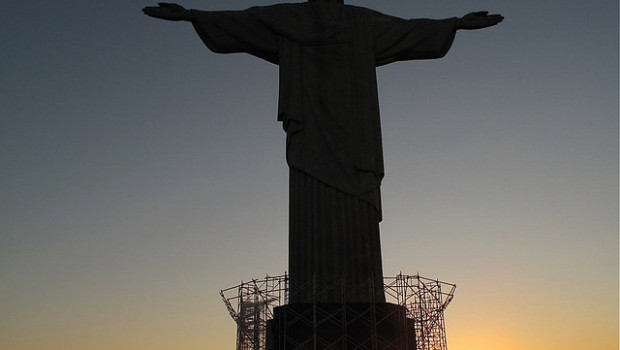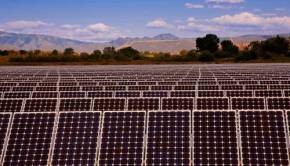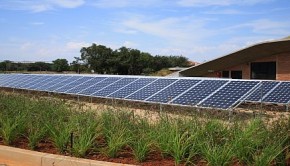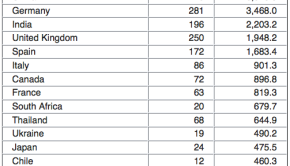Brazil Brings In Low-Cost Solar Power (In Detail)
November 5th, 2014 by Anand Upadhyay
Last week Brazil entered the solar sector with a bang, after releasing contracts totalling 1048 MW spread over 31 solar parks. This would call for an investment of over $1.66 billion. Most importantly, the average price of these solar projects was very low. In this piece, we take a look at the growth of solar power in Brazil and what might be in store for future.
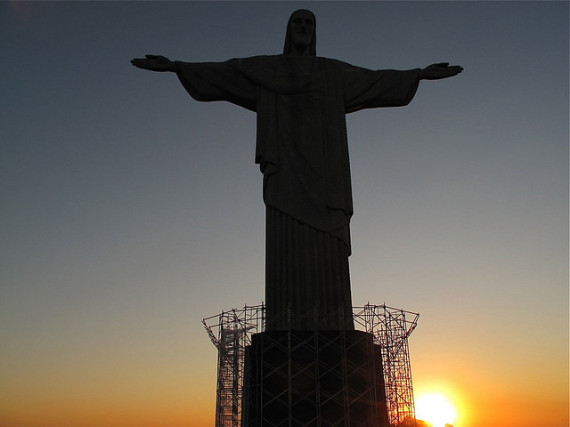
Sun rising on Christ the Redeemer at Rio de Janeiro, Brazil. Image Credit: Charlie Phillips (CC 2.0)
After the oil shock of the ’70s, Brazil took to alternative sources of energy and transformed itself into a hydropower giant. Hydroelectricity currently accounts for over 70% of the electricity generated in Brazil. The remaining comes from a mix of gas, oil, wind, biomass, and others.
But the drought during 2000–2002 proved that reliance on hydropower was not sufficient and Brazil was forced to ration electricity usage. Also, not to over-stress, but large-scale hydropower is not exactly environment friendly.
Brazil has been very rich in almost all energy resources — both fossil fuels and renewables. So, in the post-2002 period, there was a focus on diversifying into wind and biomass based power generation. Now, once again, three years of below-average rains have depleted reservoirs and sent the country scrambling to further diversify its energy mix.
Falling PV prices have come just in time to entice the country to pursue solar power. With over 280 sunny days, Brazil has huge solar power potential. But this is largely untapped as the country sources less than 1% of its electricity from solar. Around 44 MW solar capacity has come up, mostly in the form of distributed generation to support telecom towers and remote rural communities — this is really a small amount. Solar-powered stadiums for the 2014 Football World Cup have also gained a lot of attention. But they only equate to so much.
Last week, however, the country entered the solar sector with a bang after releasing contracts totalling 1048 MW spread over 31 solar parks. Brazil’s National Electric Energy Agency (ANEEL), concluded its first exclusive solar power auction, providing 20-year PPAs to companies that will invest over $1.66 billion. Power production is expected to start by 2017.
Brazil’s previous rendezvous with solar power was not fruitful. An auction of 2,700 MW of solar PV bid in late 2013 was disappointing for solar developers. None of the projects moved ahead, as solar had to compete with lower-cost resources (i.e., wind).
The failure of this auction prompted the Brazilian state of Pernambuco to push for 180 MW of solar PV projects by itself. This was carried out in December 2013 at an electricity price of $98/MWh — which made solar a good investment. However, only 150 MW of capacity cleared the tables.
The just-finished auctions have renewed interests in the Brazilian solar market. The market expectations were a mere (relatively speaking) 500 MW. However, the offer was oversubscribed by over 200 times! Solar developers bid more than 400 projects with a total capacity of over 10,000 MW.
A ceiling of $106/MWh had been set on the solar electricity price. However, when the project developers started reverse bidding, the average price of electricity (for the 1048 MW worth of projects which will see the light of day, pun intended) came down to $89/MWh. That’s very low, lower than what fossil fuels or nuclear can offer. In fact, if you noticed our coverage of solar tenders in the Indian state of Andhra Pradesh, even there the price of solar electricity was about $87/MWh at the lowest end.
It is important to note that the prices proposed by solar developers are free from any subsidy. As per BNEF, the LCOE of solar electricity in Brazil would be around $95/MWh. So, clearly, by quoting so low, either the project developers are bullish that they can drive down the costs of their projects or else they are ready to do ignore the low returns so as to grab a piece of the nascent market.
It is also being pointed out that an added reason for solar starting on such a competitive note in Brazil could be that many projects will come up in areas with wind farms, thereby saving time and money on land and transmission lines.
Brazilian power developers Solatio Energia and Renova Energia SA, along with Italy’s Enel Green Power, have won more than 70% of the solar capacity awarded in the event.
Enel alone has been awarded over 25% of the available capacity, which would entail an investment of $400 million. The company already has a significant presence in the Chilean solar market.
Brazil has set itself a goal of having 3.5 gigawatts of solar capacity in operation by 2023, producing about 1.8% of the country’s energy. The country also has big plans to start local manufacturing of solar components.
As of now, solar panels and other equipment need to be imported and are quite expensive. Dr. Rodrigo Lopes Sauaia explained in an interview to Intersolar that panels and inverters attract import duties of 28% and 81%, respectively. A bill has (supposedly) been tabled in the Brazilian Senate that proposes the reduction of import taxes on solar components.
In the recently released Climatescope 2014, a country-by-country assessment focused on the climate investment of 55 emerging markets, Brazil was placed second. It scored the highest for “enabling framework.”
While the solar market has started on an exciting note, a lot of hard work is still in store. Brazil’s energy ministry has ranked the various sources of energy according to availability, cheapness, renewability, and whether Brazil has the necessary technology. Amongst the available options — hydropower comes top, followed by wind power and biomass (mostly bagasse). These would prove to be tough competition to solar. Claudio Sales of Acende Brasil, an energy-research institute in an interview to The Economist very aptly notes:
“Brazil is very lucky: it has many choices about how to expand its electricity supply. But they are choices, and they need to be made.”
Keep up to date with all the hottest cleantech news by subscribing to our (free) cleantech newsletter, or keep an eye on sector-specific news by getting our (also free) solar energy newsletter, electric vehicle newsletter, or wind energy newsletter.
-
jnistler
-
Matt
-
http://solarmarket.in/ anand upadhyay
-
Bob_Wallace
-
http://solarmarket.in/ anand upadhyay
-
-
-
JamesWimberley
-


